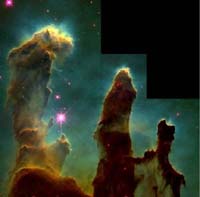In the
Beginning
The whole Solar System developed
from a cloud of dust and gas called a nebula. Scientists
believe that all the stars in the Universe formed from a nebula
that collects together through the force of gravity.
Astronomers believe that at the
beginning of the Universe most of
the matter that existed was in the form of hydrogen.
The hydrogen atom is the
simplest atom that exists: it has one proton and one electron .
Element
Factory
If most of the
matter that existed was once hydrogen how did oxygen, nitrogen, iron,
calcium and the rest of the elements develop?
Good question!
 Astronomers believe
stars are the factories that made all of the other elements and that
they use hydrogen as the fuel and the raw material to make them. Astronomers believe
stars are the factories that made all of the other elements and that
they use hydrogen as the fuel and the raw material to make them.
 Stars may not
be alive in the same way that we are, but they do have a
beginning, a middle and an end to their existence. It just happens that
a
star’s lifetime is measured in many millions or billions of years.
Since
we tend to hang out around in life for less than a century, stars seem
unchanging
to us. Stars may not
be alive in the same way that we are, but they do have a
beginning, a middle and an end to their existence. It just happens that
a
star’s lifetime is measured in many millions or billions of years.
Since
we tend to hang out around in life for less than a century, stars seem
unchanging
to us.
The Power of Attraction
In the beginning, the universe
was a bunch of gas and dust spreading out in space. Over a very long
time, this gas and dust started gathering together into clumps, or
clouds through the force of gravity. In everything that exists, every
atom has a gravitational pull that wants to attract something to it. As
matter collects together, its
gravitational pull gets stronger and it can reach out farther to grab
more
matter. That increases its gravitational pull even more. This
process
continues until there is nothing more to grab.
|
|
| A Star is Born |
|
 This
image from the Hubble Telescope is of the Eagle Nebula. The large
pillars are called "elephant trunks." They are light-years in length
and are so dense that the gas in them
contracts gravitationally and forms stars! This
image from the Hubble Telescope is of the Eagle Nebula. The large
pillars are called "elephant trunks." They are light-years in length
and are so dense that the gas in them
contracts gravitationally and forms stars!
(Click
on the image for a closer look.)
Image Credit: J.
Hester, P. Scowen (ASU), HST, NASA
|
| Supernova
1987a |
|
 In February 1987,
light reached Earth from a star more than 170 thousand light years from
Earth. The light was from a star that exploded in the nearby Large
Magellanic Cloud galaxy. Named Supernova 1987a, it is the closest
supernova since the invention of the telescope. The exlposion of the
star shot huge amouts of gas, light, and neutrinos out into space. In February 1987,
light reached Earth from a star more than 170 thousand light years from
Earth. The light was from a star that exploded in the nearby Large
Magellanic Cloud galaxy. Named Supernova 1987a, it is the closest
supernova since the invention of the telescope. The exlposion of the
star shot huge amouts of gas, light, and neutrinos out into space.
(Click
on the image for a closer look.)
Image Credit: C. S. J.
Pun (GSFC) & R. Kirshner (CfA), WFPC2, HST, NASA
|
Get the picture?
This gravity feeding frenzy will
continue until there is no more matter nearby to pull in.
Next Page
|